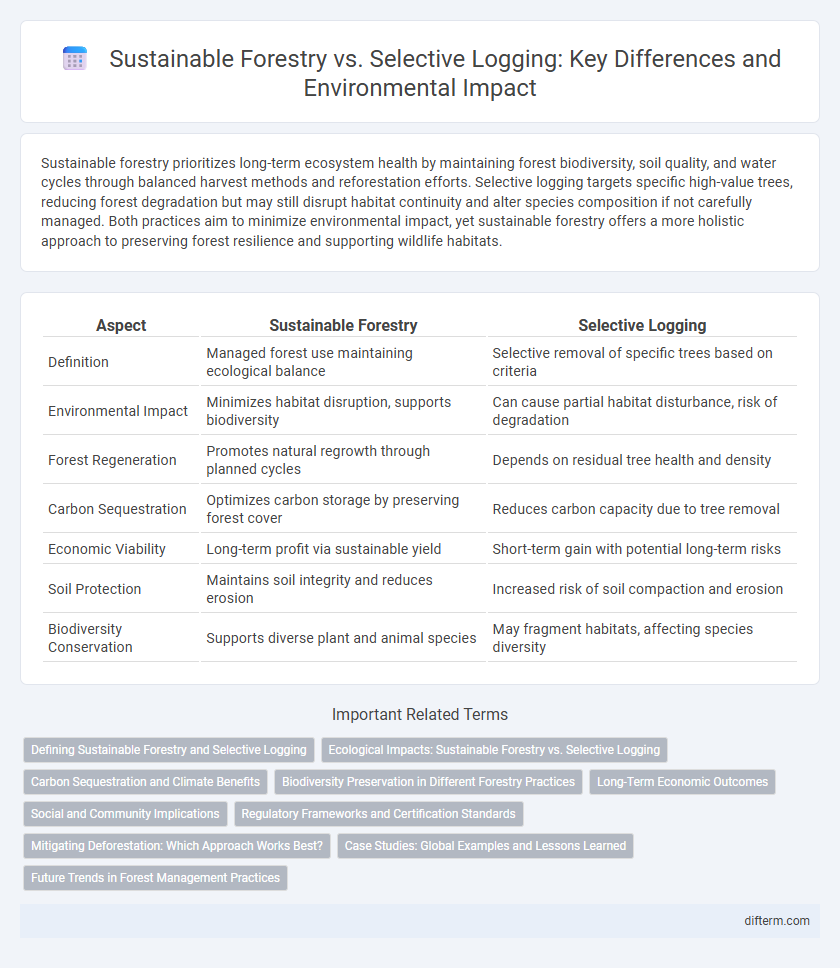Sustainable forestry prioritizes long-term ecosystem health by maintaining forest biodiversity, soil quality, and water cycles through balanced harvest methods and reforestation efforts. Selective logging targets specific high-value trees, reducing forest degradation but may still disrupt habitat continuity and alter species composition if not carefully managed. Both practices aim to minimize environmental impact, yet sustainable forestry offers a more holistic approach to preserving forest resilience and supporting wildlife habitats.
Table of Comparison
| Aspect | Sustainable Forestry | Selective Logging |
|---|---|---|
| Definition | Managed forest use maintaining ecological balance | Selective removal of specific trees based on criteria |
| Environmental Impact | Minimizes habitat disruption, supports biodiversity | Can cause partial habitat disturbance, risk of degradation |
| Forest Regeneration | Promotes natural regrowth through planned cycles | Depends on residual tree health and density |
| Carbon Sequestration | Optimizes carbon storage by preserving forest cover | Reduces carbon capacity due to tree removal |
| Economic Viability | Long-term profit via sustainable yield | Short-term gain with potential long-term risks |
| Soil Protection | Maintains soil integrity and reduces erosion | Increased risk of soil compaction and erosion |
| Biodiversity Conservation | Supports diverse plant and animal species | May fragment habitats, affecting species diversity |
Defining Sustainable Forestry and Selective Logging
Sustainable forestry encompasses practices that maintain ecological balance by ensuring forest regeneration, biodiversity conservation, and long-term resource availability. Selective logging involves the targeted removal of specific tree species or sizes to minimize environmental disruption and support forest recovery. Both methods aim to balance economic needs with environmental stewardship, but sustainable forestry adopts a holistic approach encompassing social, economic, and ecological dimensions.
Ecological Impacts: Sustainable Forestry vs. Selective Logging
Sustainable forestry maintains ecosystem balance by promoting biodiversity, soil health, and water quality through careful planning and regeneration practices. Selective logging targets specific trees but can disrupt habitat structure and increase vulnerability to pests, diseases, and erosion if not managed properly. Research shows sustainable forestry reduces carbon emissions and preserves ecological functions better than conventional selective logging methods.
Carbon Sequestration and Climate Benefits
Sustainable forestry enhances carbon sequestration by maintaining continuous forest cover, promoting biodiversity, and enabling long-term storage of carbon in biomass and soil. Selective logging, while less destructive than clear-cutting, can disrupt carbon storage by removing key tree species and altering forest structure, leading to reduced climate benefits. Implementing sustainable forestry practices maximizes climate mitigation potential by preserving ecosystem resilience and fostering natural carbon sinks.
Biodiversity Preservation in Different Forestry Practices
Sustainable forestry prioritizes biodiversity preservation by maintaining diverse habitats and protecting native species, whereas selective logging can disrupt ecosystems by targeting specific trees and potentially reducing species variety. Studies show that sustainable forestry practices support the regeneration of forests and the survival of endangered flora and fauna more effectively than selective logging. Implementing sustainable forestry standards, such as continuous cover forestry, enhances ecosystem resilience and promotes long-term biodiversity conservation.
Long-Term Economic Outcomes
Sustainable forestry practices ensure long-term economic gains by maintaining forest health and biodiversity, leading to consistent timber yields and ecosystem services. Selective logging provides short-term financial benefits but often results in degraded forest structure, reducing future productivity and increasing restoration costs. Investing in sustainable forestry promotes resilient forest economies and supports ongoing revenue streams over decades.
Social and Community Implications
Sustainable forestry promotes long-term ecological balance and supports the livelihoods of local communities by maintaining forest resources and biodiversity. Selective logging, while less destructive than clear-cutting, can still disrupt social structures if not carefully managed, leading to unequal resource access and potential conflicts. Community engagement and equitable benefit-sharing are essential to ensure forestry practices contribute positively to social well-being and cultural preservation.
Regulatory Frameworks and Certification Standards
Sustainable forestry is governed by comprehensive regulatory frameworks such as the Forest Stewardship Council (FSC) and Programme for the Endorsement of Forest Certification (PEFC), which set stringent criteria for ecological balance and long-term forest health. Selective logging practices often fall under these certifications but require rigorous monitoring to ensure compliance with rules that prevent overharvesting and biodiversity loss. Enforcement mechanisms and standardized audits within these certification standards promote accountability and transparency in forest management, supporting sustainability goals.
Mitigating Deforestation: Which Approach Works Best?
Sustainable forestry ensures long-term ecosystem health by maintaining biodiversity, soil quality, and carbon storage, whereas selective logging targets specific trees to reduce immediate environmental impact but can still degrade habitats over time. Studies show sustainable forestry practices, such as continuous cover management and reforestation, mitigate deforestation more effectively by preserving forest structure and promoting natural regeneration. Implementing sustainable forestry policies leads to greater carbon sequestration and resilience against climate change compared to selective logging methods.
Case Studies: Global Examples and Lessons Learned
Case studies from the Amazon rainforest and Southeast Asian forests demonstrate that sustainable forestry practices, such as reduced-impact logging, significantly minimize ecological damage compared to selective logging. Research in Indonesia reveals that sustainable forestry maintains higher biodiversity levels and improves carbon sequestration, fostering long-term ecosystem resilience. Lessons learned emphasize the importance of community involvement and strict regulatory frameworks to ensure effective implementation and enforcement worldwide.
Future Trends in Forest Management Practices
Future trends in forest management emphasize sustainable forestry techniques that balance ecological health with economic needs, promoting biodiversity preservation and carbon sequestration. Selective logging, by targeting specific trees, minimizes environmental impact and supports forest regeneration more effectively than clear-cutting. Advances in remote sensing and data analytics enhance monitoring capabilities, fostering adaptive management strategies that align with climate resilience goals.
sustainable forestry vs selective logging Infographic

 difterm.com
difterm.com